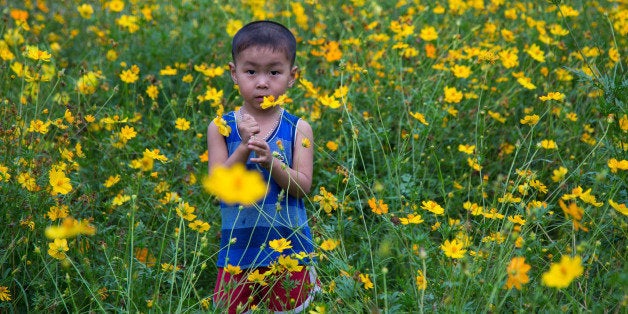
When you think about climate change, what do you think about? Disasters? Rising sea-levels? The future of polar bears?
Through my work in developing countries, children and young people tell me they don't just think about future consequences; the impacts of climate change are affecting them now.
Climate change presents a real and urgent threat to vulnerable children and the communities they live in. Communities in the north of Vietnam tell me that rainfall patterns have changed during their lifetimes. They can't rely on growing traditional crops and landslides are a greater threat because of shorter, more intense wet seasons. Children in villages on the east coast of the Philippines tell me the typhoon season is different compared to when their parents were little. High school students in the Pacific explain the coastlines of their islands are changing even during the short course of their own lives.
Children and young people are particularly exposed to the impacts of climate change. Many natural disasters will become more frequent or more intense as a result of climate change, and boys and girls are often disproportionately affected by these natural disasters through loss of life or health impacts. This is for a range of reasons, including their smaller body size, inability to swim, that they become separated from their parents, or that they are too young to read or comprehend warnings or response instructions. Changes to family crops and livelihoods as a result in changing weather patterns can result in malnutrition and disasters and changes to family income can both lead to a lack of access to school. Because the decisions we take today about how to address climate change will only be felt in the future, we have an obligation to children on climate change.
The basic rights of children are seriously threatened by climate change. The Convention on the Rights of the Child outlines that all girls and boys, wherever they are in the world, hold the right to a full and healthy life: the right to food, and the right to education. Because these (and many other) rights are threatened by climate change, we have a duty to ensure children everywhere are able to achieve these rights. Moreover, by sheer dint of numbers, children and young people are one of the largest groups affected by climate change. They should therefore be front and centre of any discussions and decision making on this issue.
But children aren't passive victims. There countless children and young people around the world taking action on climate change. Through my work with Plan International, I've seen children raise awareness on climate change in their communities, in their countries, and internationally through activism, theatre and music, short films, online campaigns and more. I've seen university students in Vietnam running projects to teach rural villagers how to compost their rice husks to create organic fertilizers that both reduce the burning of waste and increases the villagers' crop yields. I've seen young people designing, implementing and monitoring projects in their own communities to address the impacts they've identified will affect them. Around the world children are running renewable energy projects, planting and conserving trees and forests and motivating political action. They are demonstrating true leadership on an issue that is critical to them and their futures.
However there are very few mechanisms for young people's voices on climate change to be formally heard through the UN system, particularly the United Nations Framework Convention on Climate Change (the UNFCCC), nor are there many opportunities for them to be incorporated into the actions resulting from these discussions. The same is often true at national and local decision-making levels too. Yet around the world, we are seeing amazing action being taken by children and young people on this issue -- convincing decision-makers to take action, as well as carrying out efforts to reduce greenhouse gas emissions and prepare for the impacts of climate change in their own communities and beyond.
When world leaders meet at the Secretary-General's Climate Summit this month, I urge them not only to think about children, but to include them.
This post is part of a month-long series produced by The Huffington Post in conjunction with a variety of events being held in September recognizing the threats posed by climate change. Those events include the UN's Climate Summit 2014 (to be held Sept. 23, 2014, at UN headquarters in New York) and Climate Week NYC (Sept. 22-28, 2014, throughout New York City). To see all the posts in the series, read here.